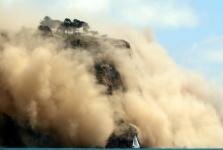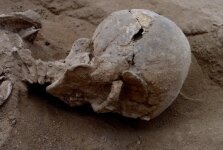
Tunisians gather to mourn the victims of the attack on the Bardo museum. Photograph: Nicolas Fauqué/Corbis
The names and stories of some of those killed at Tunis’ Bardo museum have been revealed as other countries scramble to identify their citizens.
Japan and several other countries were frantically trying to establish the identities of citizens who were killed or injured in Wednesday’s terrorist attack in Tunis, as reports emerged of a multinational death toll of at least 20 people, most of them tourists.
As authorities in the Tunisian capital tried to account for the dead and injured amid conflicting reports of the number of people and nationalities involved, the country’s prime minister, Habib Essid, said people from at least eight countries had died.
The dead include three Japanese, four Italians, two Colombians, two Spaniards, an Australian, a Pole, a French national and one whose nationality yet to be verified, Essid said. Other reports said an unknown number of South African tourists may have been involved.
On Wednesday night, a South African government spokesman, Clayson Monyela, said it was too soon to say how many South Africans had been caught up in the attack.
“We are working with local authorities to establish the identities of the South Africans and in providing consular assistance. We condemn this cowardly and barbaric attack in the strongest terms possible,’’ Monyela said.
Two Tunisians – a bus driver and a policeman – also died in the attack, along with the two gunmen, named by Essid as Yassine Laabidi and Hatem Khachnaoui.
At least 44 people were wounded, including 13 Italians, seven French, four Japanese, two South Africans, one Pole, one Russian and six Tunisians. Essid did not provide any information regarding the nationalities of the other wounded.
Two Britons were “caught up in” the shootings, the UK Foreign Office said, but did not specify whether they were among the dead or injured.
As details emerged on Thursday about the victims’ identities, the Australian prime minister, Tony Abbott, confirmed reports that an Australian-Colombian man was among the dead.
Social media named him as business analyst Javier Camelo, a 28-year-old from the Waterloo area of Sydney, who also held Colombian citizenship.
Camelo, who reportedly worked for American Express in Sydney, was killed along with his mother, who was named as Miriam Martínez.
Camelo, a former student at the University of Sydney, graduated this year with an MBA from Spain’s IE Business School.
“Today American Express mourns the loss of our much-loved colleague, Javier Camelo, who tragically lost his life in yesterday’s incident in Tunisia,” the managing director of American Express Australia and New Zealand, Rachel Stocks, said in a statement. “Our thoughts and prayers go out to Javier’s friends and family during this difficult time.”
In a message posted on Facebook, Rasia Sanderson, a friend of Camelo, said she was heartbroken and thanked him for the laughter, adventure and fun times they had had together.
“Dear Javi, I always imagined I would see your name on the news due to your great achievements in life,” Sanderson wrote. “But never as one of the victims of those terrorist attacks that always feel so far away through TV and computer screens.”
Camelo was the son of a retired Colombian army general, José Arturo Camelo, who was visiting Tunis with his wife and their two sons as part of a Mediterranean cruise. Camelo Snr told local radio in a phone interview from Tunis that he and the couple’s second son, who was not identified, were unharmed.
The Colombian president, Juan Manuel, wrote on Twitter: “We lament the
death of two Colombians in Tunis and offer condolences to their family.”
Camelo and his family were part of a tour group of 40 tourists that included Mexicans, Spaniards, Argentinians and Brazilians, as well as the Colombians, according to Spain’s EFE news agency.
Japan said later that three, not five, of its citizens were among the dead.
Kyodo new agency, citing government sources, said the three were all women: Machiyo Narusawa, 66, from Tokyo, and Chiemi Miyazaki, 49, and Haruka Miyazaki, 22, who are believed to be a mother and daughter from Saitama Prefecture.
The prime minister, Shinzo Abe, described the attack as a “despicable act of terrorism”.
Public broadcaster NHK quoted officials as saying that some of the names on the initial list of Japanese victims overlapped, hence the earlier claim that five had died.
“At one point, there was a report that five [Japanese] had died, but that was an error,” the chief cabinet secretary, Yoshihide Suga, told reporters.
The death toll of three was greeted with dismay in Japan, which is still reeling from the murders, by beheading, of two of its citizens in Syria earlier this year.
“We are doing our best to confirm the whereabouts of Japanese nationals [in Tunis],” Abe told reporters. “I extend my deepest condolences to those who have lost a family member in this event.
“And whatever the reasons, we can absolutely not forgive acts of terrorism and we strongly condemn them. We plan to work with the international community to strengthen our cooperation and fight against terrorism.”
The US first lady, Michelle Obama, who is on a visit to Tokyo, said: “I want to express our condolences over the horrific events yesterday in Tunisia. Our hearts go out to the loved ones of those killed they are very much in our thoughts and prayers today.”
Noriko Yuki, a 35-year-old Japanese survivor, said she was lucky to be alive after she and her mother were hit in a hail of bullets.
“I was crouching down with my arms over my head, but I was shot in the ear, hand and neck,” Yuki said from her hospital bed in comments aired by NHK.
“My mother beside me was shot in the neck. She couldn’t move by herself when the police came over.”
She did not say exactly what had happened to her 68-year-old mother, only that she had been rushed to another hospital for surgery.
Some of the victims were on a cruise operated by the Italian company Costa Crociere, which said 14 of its passengers had failed to return to the ship, the Costa Fascinosa, on Wednesday.
The company said it was in close contact with local security authorities and the Italian foreign ministry. The ship left Tunis, without the missing passengers, just before 2am local time on Thursday, reports said.
The first of three Italian victims to be named was Francesco Caldara, a 64-year-old pensioner from the northern Italian city of Novara, according to La Stampa. It reported that Caldara was killed in a spray of bullets while he sat on a bus that had been parked outside the Bardo museum.
Caldara was visiting Tunis as part of a Costa cruise, which was touring the Mediterranean for seven days. His partner, Sonia Reddi, was also wounded in the attack and both were taken to hospital, where Caldara died.
“Sonia called me at 12:30. She was crying and desperate,” Reddi’s sister Wanda told the Italian newspaper Il Venerdì.
“She told me that she was injured in her arm but that she feared that Francesco was dead. She called back at one o’clock and talked to my daughter Milena. She was in shock and said her partner had been seriously injured.”
Reddi said the call then ended. The couple had left Italy on Sunday, according to Reddi’s family. They were on holiday to celebrate Reddi’s birthday. Their next destination was supposed to be Mallorca.
Spain’s foreign minister, José Manuel García-Margallo, said two Spaniards died in the attack. He told El País that they were a retired couple from Catalonia who had arrived in Tunis on a cruise. About 90 Spaniards from two cruises were in Tunis on Wednesday.
The French president, Francois Hollande, said he was saddened by news of the deaths of two French nationals, and expressed solidarity with the people and government of Tunisia. Hollande said seven other French tourists had been injured.
Eyewitnesses spoke of the confusion and terror that spread through the museum as visitors looked on helplessly as the gunmen opened fire on tourists as they got off buses outside the building and then chased them inside.
Spanish eyewitness Josep Lluis Cusido, who was already inside the museum when the attack started, said he had hidden behind a pillar.
“We saw a bunch of people leaving a vehicle and they started shooting everyone walking down the plaza at that moment,” Cusido told Spain’s
Cadena Ser radio.
Cusido, the mayor of the Spanish town of Vallmoll, said he and his wife spent nearly three hours inside the museum before getting out unharmed.
“After they entered the museum, I saw their faces,” he said. “They were about 10 meters away from me, shooting at anything that moved. I managed to hide behind a pillar, there were unlucky people who they killed right there. I was lying on the floor almost three hours but our lives were saved.”





